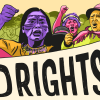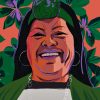Many of us have been raised with the idea that you do not take what does not belong to you. This is, however, not always so obvious. Every single day, especially in the developing world, people are driven off their land for the sake of foreign investments. In the last decade alone foreign investments have led to the acquisition of more than 81 million acres of land worldwide –an area the size of Portugal, with unspeakable consequences for many rural and forest dwellers across the world. This is caused by the widespread and enduring lack of clarity and recognition of indigenous and community land and resource rights. When land rights are weak or insecure Indigenous Peoples and local communities risk losing access to land and resources they heavily depend on. Unfortunately insecurity of land tenure is commonplace in the developing world. Today the ownership of roughly half of the rural forest and dry land areas of Africa, Asia and Latin America is contested, placing the lives and livelihoods of at least two billion people at risk.
Securing and protecting that ownership is not only of great importance for social and economic development, but also for progress on human rights, food security, environmental conservation and confronting and adapting to climate change. This is due to the fact that land rights contribute to a diverse range of benefits and social values. As shown in a compiled report by the International Land Coalition (ILC), access to land rights is linked to food security, productivity, well-being and dignity, empowerment, gender equality and environmental protection. That means that securing indigenous and community land and resource rights is key in the face of global challenges, such as eradicating hunger and poverty, promoting gender equality and ensuring environmental protection. Moreover, as stated by Jenny Springer in a guest blog from the Rights and Resources Initiative (RRI), ‘explicit inclusion of secure land rights for local communities and Indigenous Peoples is key to “leaving no one behind” in global sustainable development goals’.

Many organizations worldwide have come to acknowledge the need to join hands in securing indigenous and community land and resource rights. During the 2013 Interlaken Conference on Scaling-up Strategies to Secure Community Land and Resources Rights this has led to the development of The Global Call to Action on Indigenous and Community Land Rights. Guided by the ILC, RRI and Oxfam, the Global Call to Action has the goal ‘to double the area of land recognized as owned or controlled by indigenous peoples and local communities by 2020’. Building on the efforts of existing networks and organizations, this global network is set to facilitate greater collaboration and collective action around the world. Through these efforts change will happen by enabling and supporting the recognition, implementation, and upholding of indigenous and community land rights at the national level, which is where rights and tenure governance institutions are determined. Only then will we move forward, while leaving no one behind.
To draw attention to, and move towards the stated goal of, the Global Call to Action, Oxfam, ILC and RRI are organizing a Policy Roundtable on ‘Scaling up strategies to secure Indigenous and Community Land Rights’ at the Annual World Bank Conference on Land and Poverty. At this invited session experiences from local communities and civil society organizations around the world are brought together to serve as an opportunity to build and expand collaborations, commitments and investments for strengthening indigenous and community land rights from local to global scales. The speakers, including Samuel Nguiffo, Richard Smith, Peter Veit, Jennifer Corpuz and Rachael Knight, will highlight the current challenges that undermine tenure security for indigenous and community land right and will identify concrete examples of positive change that should be supported and upscaled.
By Maarten van Bijnen


